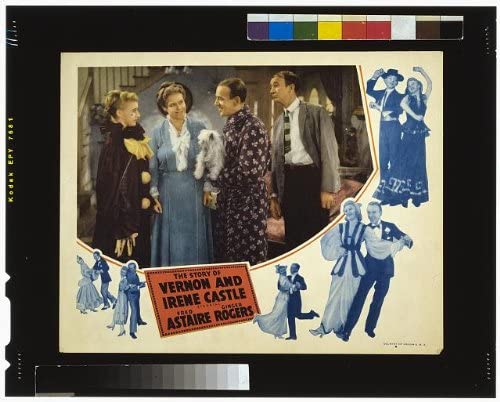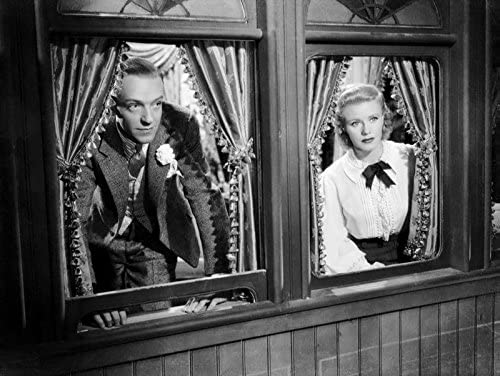The Story of Vernon and Irene Castle (1939) starring Fred Astaire, Ginger Rogers,
The Story of Vernon and Irene Castle is a wonderful Hollywood biography. It tells the story of the husband-and-wife ballroom dancing team Vernon and Irene Castle.
Review
![]() The Store of Vernon and Irene Castle is not only my favorite Fred Astaire and Ginger Rogers movies. It’s one of my favorite movies. period. It’s the story of a true love story, complete with ups and downs. The film’s sweet, well done, with good acting and dancing. It’s compelling … And the end is heart-breaking. I recommend it wholeheartedly.
The Store of Vernon and Irene Castle is not only my favorite Fred Astaire and Ginger Rogers movies. It’s one of my favorite movies. period. It’s the story of a true love story, complete with ups and downs. The film’s sweet, well done, with good acting and dancing. It’s compelling … And the end is heart-breaking. I recommend it wholeheartedly.
As normal, Hollywood does a lousy job with accuracy when doing history or a biography. That’s true here, as well. For example: the steadfast friend, played wonderfully here by Walter Brennan … Was an African American.
Editorial review of The Story of Vernon and Irene Castle courtesy of Amazon.com
The Story of Vernon and Irene Castle was the last of nine films Fred Astaire and Ginger Rogers made together for RKO Pictures, and it is unlike any other. For the only time, Fred and Ginger play historical characters–the legendary dancing duo that was all the rage between 1912 and 1916–and a married couple, no less. Instead of their usual innovative, plot-driving dances, Fred and Ginger perform pastiches of what the Castles made famous–the fox trot, polka, and tango. And rather than an original score of great American standards by Berlin, Kern, or the Gershwins, the film uses a collection of period tunes, including “By the Light of the Silvery Moon” and “Waiting for the Robert E. Lee.”
No, this is not Top Hat, but fans will enjoy the film anyway. Vernon and Irene Castle is an affectionate tribute to a bygone era and to a team that Fred said was “a tremendous influence” on his career. As portrayed in the film (which was based on Irene Castle’s memoirs and input), Vernon Castle is a small-time vaudeville comedian when he meets and marries Irene. The two not only manage to forge a career as proper, respectable dancers, they become the essence of style, setting national trends for dance, fashion, and even women’s hairstyles. The film briefly touches on Fred and Ginger’s usual themes of pursuit and union, but mostly they are warm and tender together as they deal with real-life problems, perhaps portraying the earlier films’ characters after those “happily ever after” fantasy endings.
And as we watch the Castles’ performing career rise and decline, straight through to the film’s touching last shot, we realize that Fred and Ginger are saying farewell, which makes The Story of Vernon and Irene Castle an appropriate finale to the most glorious partnership in Hollywood history. –David Horiuchi
Songs
- Only When You‘re in My Arms (1939) by Con Conrad – Herman Ruby Bert Kalmar, Sung by Fred Astaire, End dance: Fred Astaire and Ginger Rogers
- Moonlight Bay, Music by Percy Wenrich (1912)
- Oh, You Beautiful Doll, Written by Nat Ayer (1911), Lyrics by A. Seymour Brown
- The Glow-Worm, Written by Paul Lincke (1902), English lyrics by Lilla Cayley Robinson (1907)
- By the Beautiful Sea, Written by Harry Carroll (1914), Lyrics by Harold Atteridge
- The Yama Yama Man, Written by Karl Hoschna (1908), Lyrics by George Collin Davis, Sung and Danced by Ginger Rogers
- Come, Josephine in My Flying Machine, Written by Fred Fisher (1910), Lyrics by Al Bryan
- By the Light of the Silvery Moon, Written by Gus Edwards (1909), Lyrics by Edward Madden
- Cuddle Up a Little Closer, Written by Karl Hoschna, Lyrics by Otto A. Harbach (1908)
- King Chanticleer, Written by Nat Ayer, Lyrics by A. Seymour Brown
- Waiting for the Robert E. Lee, Written by Lewis F. Muir (1912), Lyrics by L. Wolfe Gilbert, Danced by Fred Astaire and Ginger Rogers
- While They Were Dancing Around, Written by James V. Monaco (1913), Lyrics by Joseph McCarthy
- The Darktown Strutters’ Ball, Written by Shelton Brooks (1917), French lyrics by Elsie Janis
- Little Brown Jug, Written by Joseph Winner (1869)
- Hello, Frisco, Hello, Written by Louis A. Hirsch (1915), Lyrics by Gene Buck
- Way Down Yonder in New Orleans, Written by Turner Layton (1922), Lyrics by Henry Creamer
- Take Me Back to New York Town, Written by Harry von Tilzer (1907), Lyrics by Andrew B. Sterling
- It’s a Long, Long Way to Tipperary, Written by Jack Judge and Harry Williams (1912)
- Hello! Hello! Who’s Your Lady Friend, Written by Harry Fragson (1914), Lyrics by Worton David and Bert Lee
- Over There, Written by George M. Cohan (1917)
Trivia
- The real Irene Castle served on the production team and was considered hard to please. According to Ginger Rogers, who plays Irene in the film, Castle disliked every costume that she wore and deemed them to be anachronistic. Due to censorship restrictions, Rogers’ costumes evoked the staid 1939 fashions rather than the styles of Castle’s era. When Rogers refused to cut her hair to accurately portray the bob hairstyle that Irene had created, Castle became even more displeased.
- The character of Maggie Sutton (played by Edna May Oliver) was based upon the Castles’ openly lesbian manager, Elisabeth Marbury. Due to the post-1934 Hays Code’s rigid ban regarding on-screen homosexuality, the film omits Marbury’s lesbianism.
- Irene Castle criticized the casting of white actor Walter Brennan to portray her life-long companion and manservant Walter, who WAS Black. She also noted that she and her husband always toured with a Black orchestra, James Reese Europe’s Society Orchestra, not a white band. Studio executives overruled Castle’s protests in order for the film to play in theatres throughout the Southern United States. Due to the film’s factual errors and conservative depiction of the era, Castle disowned the film.




